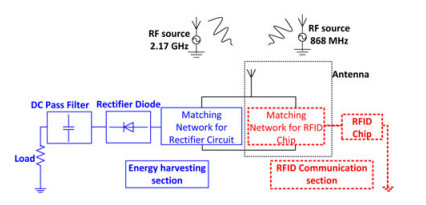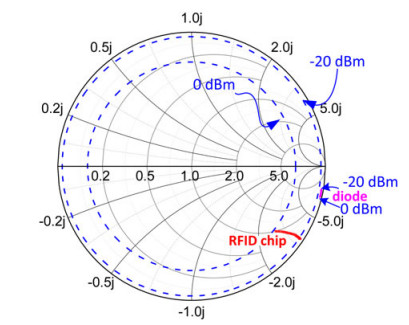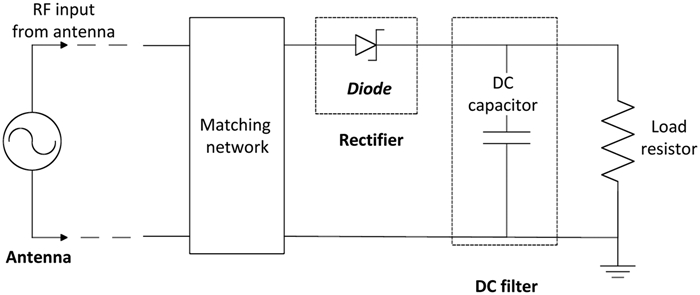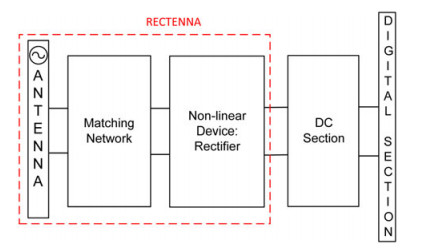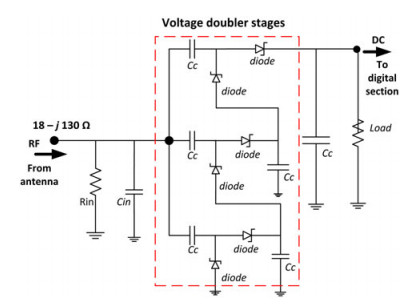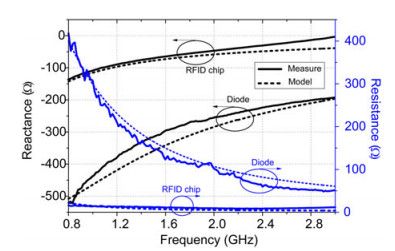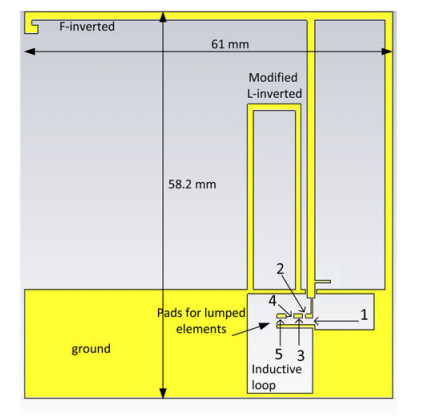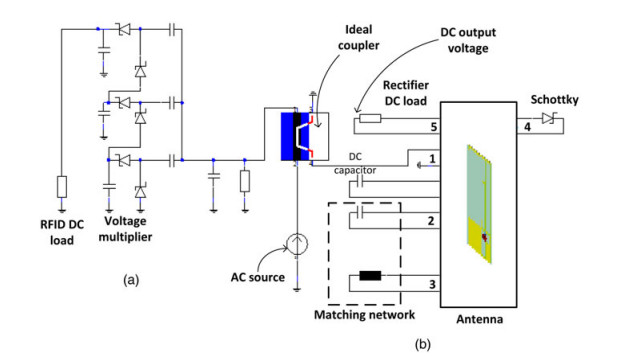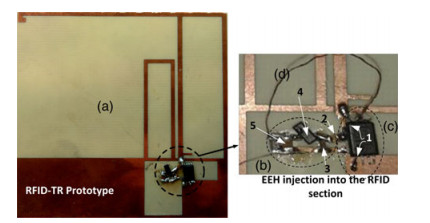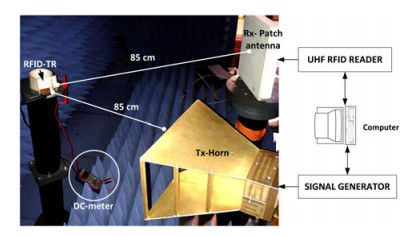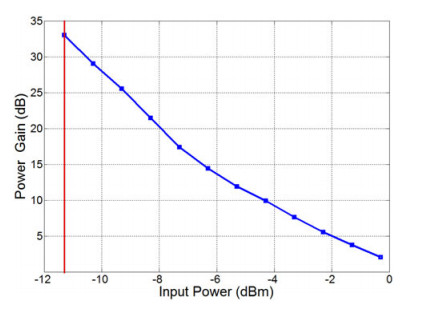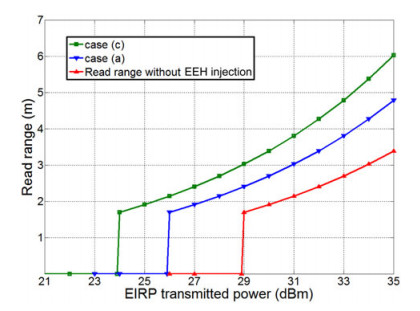Exploitation of the nonlinearities in electromagnetic energy harvesting and passive UHF RFID
-
1.
University of Grenoble, Alpes, LCIS, 50 rue Barthélémy de Laffemas, 26902 Valence, France. Phone: +33 475 759 442
-
2.
Sinhgad Engineering Institute, 19-15, Smt Khilare Marg, Off Karve Road, Erandwane, Pune, India
-
3.
Ampere Laboratory, Lyon University, 43 boulevard du 11 novembre 1918, 69622 Villeurbanne, France
More Information
-
Author Bio:
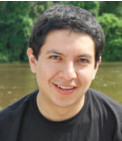 Gianfranco Andia-Vera
Gianfranco Andia-Vera He was born in Puno, Peru, in 1986. He received the dual M.Sc. degree in telecommunications engineering from the Universitat Politecnica de Catalunya (UPC), Barcelona, Spain, and the Pontificia Universidad Catolica del Peru (PUCP), Lima, Peru, in 2009, the Postgraduate degree in development and management of networks on information technology from UPC, in 2010, and the Ph.D. degree in optics and radiofrequency from the Grenoble Institute of Technology (Grenoble INP), Valence, France, in 2014. He was a Communication Engineer involved in RF planning and network deployment for a telecom carrier from 2009 to 2011. From 2011 to 2015 he has been with the Laboratoire de Conception et d'Integration des Systemes. His current research interests include RFID, antennas, energy harvesting, wireless networks, and microwave devices. Since 2016 he is RF Engineer in Primo1D and contributes to the development of textil-based RFID applications. He serves as an expert-reviewer for international scientific committees, including IEEE (MTT, MWCL, and Sensors), IET (AP), Cambridge (WPT, IJMWT).
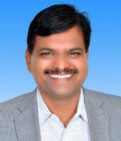 Shankar Nawale
Shankar Nawale was born on September 25, 1977 in India and received B.E. degree from Dr. B. A. M. University, Aurangabad, (MS), India in 2000, M. Tech. in Electronics and Telecommunication Engineering and Ph.D. in Electronics Engineering from Veermata Jijabai Technological Institute (VJTI), University of Mumbai, (MS), India in 2008 and 2013, respectively. Currently, he is an Associate Professor at Sinhgad Institute of Technology, Lonavala, Pune, MS, and was Head of the Department, Electronics and Telecommunication Engineering since July 2007, where he has taught the subjects such as Electromagnetics, Wave Theory, Antennas, and Microwave Engineering. He is currently working on Energy Harvesting in passive RFID applications.
 Yvan Duroc
Yvan Duroc received the Teaching degree Agregation (French national degree) in Applied Physics in 1995 from Ministry of National Education, Higher Education, and Research, France, the Ph.D. degree in Electrical Engineering from the Grenoble Institute of Technology in 2007 and the HDR degree (Habilitation Diriger des Recherches) from the Grenoble University in 2012. He was a Teaching Associate at Esisar Engineering School from 1997 to 2009, where he was an Associate Professor from 2009 to 2013. He is currently a Professor at the University Claude Bernard Lyon 1, France. He is in charge of lectures in signal and image processing, RF and microwave, electronics, and embedded systems for the engineer and M.Sc. levels. His current research interests include microwave and applied signal processing with special attention to ultra-wideband and radio frequency identification technologies, backscattered modulations, energy harvesting, sensors, and antennas. He is the member of several TPC and serves as an expert-reviewer for national and international scientific committees and conferences, including IEEE, IET, Cambridge, PIER, Hindawi, Eurasip, URSI, EUCAP, ATC, ANR, and ARC6. Professor Duroc is the Vice-chair of the URSI Commission C, France.
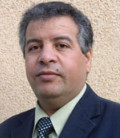 Smail Tedjini
Smail Tedjini received Doctor of Physics degree from Grenoble University in 1985, and became a full Professor in 1993. Main topics are Electromagnetism, RF, Wireless and Optoelectronics. Current research concerns wireless systems in particular RFID. He is the founder and past Director of LCIS Laboratory and actually, he was former ORSYS group leader. He supervised more than 30 Ph.D. scholars and has more than 300 publications. He served as an Examiner/reviewer for tens of Ph.D. for various universities (France, Germany, Italy, Vietnam, Australia, Singapore, India, Brazil, Maghreb, etc.). He is Member of several TPC and serves as expert for international scientific committees and conferences, including ISO, Piers, IEEE, URSI, and EuCap. He organized several conferences/workshops. He was the Past President and founder of the IEEE-CPMT French Chapter, Vice-President of IEEE France Section, and Chair of URSI Commission "D" 2011–2014. Recently, he was elected as the President of URSI – France 2015–2018
-
Corresponding author:
G. Andia-Vera Email: gianfranco.andia-vera@lcis.grenoble-inp.fr
-
Abstract
In this paper, some theoretical aspects and experimental results are discussed with the aim to provide supplementary dc energy to radio frequency identification (RFID) tags by exploiting the nonlinear nature of rectifier devices. Three nonlinear phenomena are treated: (ⅰ) the impedance power dependence, (ⅱ) the harmonic production, and (ⅲ) the dependence on the radio frequency waveform. The novelty of the work relies on proposing a double rectifier composite system in where the nonlinearity of each rectifier is exploited to enhance the global powering performance of the system. Using the passive RFID technology as a beacon for the implementation, the approach considers combining the internal rectifier circuit of a commercial RFID chip operating at 868 MHz with an external rectifier circuit operating at 2.17 GHz. The solution triggers in a composite system RFID tag-harvester integrated in a single-feed dual-band antenna. The experimental validation shows 5 dB of tag sensitivity enhancement when it is empowered by the external harvester. The enhanced sensitivity produces an increase in the theoretical reading range distance from 3.3 to 6.1 m.
-
About this article
Cite this article
Andia-Vera G, Nawale S, Duroc Y, Tedjini S. 2016. Exploitation of the nonlinearities in electromagnetic energy harvesting and passive UHF RFID. Wireless Power Transfer 3(1): 43-52 doi: 10.1017/wpt.2016.1
|
Andia-Vera G, Nawale S, Duroc Y, Tedjini S. 2016. Exploitation of the nonlinearities in electromagnetic energy harvesting and passive UHF RFID. Wireless Power Transfer 3(1): 43-52 doi: 10.1017/wpt.2016.1
|









 Gianfranco Andia-Vera He was born in Puno, Peru, in 1986. He received the dual M.Sc. degree in telecommunications engineering from the Universitat Politecnica de Catalunya (UPC), Barcelona, Spain, and the Pontificia Universidad Catolica del Peru (PUCP), Lima, Peru, in 2009, the Postgraduate degree in development and management of networks on information technology from UPC, in 2010, and the Ph.D. degree in optics and radiofrequency from the Grenoble Institute of Technology (Grenoble INP), Valence, France, in 2014. He was a Communication Engineer involved in RF planning and network deployment for a telecom carrier from 2009 to 2011. From 2011 to 2015 he has been with the Laboratoire de Conception et d'Integration des Systemes. His current research interests include RFID, antennas, energy harvesting, wireless networks, and microwave devices. Since 2016 he is RF Engineer in Primo1D and contributes to the development of textil-based RFID applications. He serves as an expert-reviewer for international scientific committees, including IEEE (MTT, MWCL, and Sensors), IET (AP), Cambridge (WPT, IJMWT).
Gianfranco Andia-Vera He was born in Puno, Peru, in 1986. He received the dual M.Sc. degree in telecommunications engineering from the Universitat Politecnica de Catalunya (UPC), Barcelona, Spain, and the Pontificia Universidad Catolica del Peru (PUCP), Lima, Peru, in 2009, the Postgraduate degree in development and management of networks on information technology from UPC, in 2010, and the Ph.D. degree in optics and radiofrequency from the Grenoble Institute of Technology (Grenoble INP), Valence, France, in 2014. He was a Communication Engineer involved in RF planning and network deployment for a telecom carrier from 2009 to 2011. From 2011 to 2015 he has been with the Laboratoire de Conception et d'Integration des Systemes. His current research interests include RFID, antennas, energy harvesting, wireless networks, and microwave devices. Since 2016 he is RF Engineer in Primo1D and contributes to the development of textil-based RFID applications. He serves as an expert-reviewer for international scientific committees, including IEEE (MTT, MWCL, and Sensors), IET (AP), Cambridge (WPT, IJMWT).  Shankar Nawale was born on September 25, 1977 in India and received B.E. degree from Dr. B. A. M. University, Aurangabad, (MS), India in 2000, M. Tech. in Electronics and Telecommunication Engineering and Ph.D. in Electronics Engineering from Veermata Jijabai Technological Institute (VJTI), University of Mumbai, (MS), India in 2008 and 2013, respectively. Currently, he is an Associate Professor at Sinhgad Institute of Technology, Lonavala, Pune, MS, and was Head of the Department, Electronics and Telecommunication Engineering since July 2007, where he has taught the subjects such as Electromagnetics, Wave Theory, Antennas, and Microwave Engineering. He is currently working on Energy Harvesting in passive RFID applications.
Shankar Nawale was born on September 25, 1977 in India and received B.E. degree from Dr. B. A. M. University, Aurangabad, (MS), India in 2000, M. Tech. in Electronics and Telecommunication Engineering and Ph.D. in Electronics Engineering from Veermata Jijabai Technological Institute (VJTI), University of Mumbai, (MS), India in 2008 and 2013, respectively. Currently, he is an Associate Professor at Sinhgad Institute of Technology, Lonavala, Pune, MS, and was Head of the Department, Electronics and Telecommunication Engineering since July 2007, where he has taught the subjects such as Electromagnetics, Wave Theory, Antennas, and Microwave Engineering. He is currently working on Energy Harvesting in passive RFID applications.  Yvan Duroc received the Teaching degree Agregation (French national degree) in Applied Physics in 1995 from Ministry of National Education, Higher Education, and Research, France, the Ph.D. degree in Electrical Engineering from the Grenoble Institute of Technology in 2007 and the HDR degree (Habilitation Diriger des Recherches) from the Grenoble University in 2012. He was a Teaching Associate at Esisar Engineering School from 1997 to 2009, where he was an Associate Professor from 2009 to 2013. He is currently a Professor at the University Claude Bernard Lyon 1, France. He is in charge of lectures in signal and image processing, RF and microwave, electronics, and embedded systems for the engineer and M.Sc. levels. His current research interests include microwave and applied signal processing with special attention to ultra-wideband and radio frequency identification technologies, backscattered modulations, energy harvesting, sensors, and antennas. He is the member of several TPC and serves as an expert-reviewer for national and international scientific committees and conferences, including IEEE, IET, Cambridge, PIER, Hindawi, Eurasip, URSI, EUCAP, ATC, ANR, and ARC6. Professor Duroc is the Vice-chair of the URSI Commission C, France.
Yvan Duroc received the Teaching degree Agregation (French national degree) in Applied Physics in 1995 from Ministry of National Education, Higher Education, and Research, France, the Ph.D. degree in Electrical Engineering from the Grenoble Institute of Technology in 2007 and the HDR degree (Habilitation Diriger des Recherches) from the Grenoble University in 2012. He was a Teaching Associate at Esisar Engineering School from 1997 to 2009, where he was an Associate Professor from 2009 to 2013. He is currently a Professor at the University Claude Bernard Lyon 1, France. He is in charge of lectures in signal and image processing, RF and microwave, electronics, and embedded systems for the engineer and M.Sc. levels. His current research interests include microwave and applied signal processing with special attention to ultra-wideband and radio frequency identification technologies, backscattered modulations, energy harvesting, sensors, and antennas. He is the member of several TPC and serves as an expert-reviewer for national and international scientific committees and conferences, including IEEE, IET, Cambridge, PIER, Hindawi, Eurasip, URSI, EUCAP, ATC, ANR, and ARC6. Professor Duroc is the Vice-chair of the URSI Commission C, France.  Smail Tedjini received Doctor of Physics degree from Grenoble University in 1985, and became a full Professor in 1993. Main topics are Electromagnetism, RF, Wireless and Optoelectronics. Current research concerns wireless systems in particular RFID. He is the founder and past Director of LCIS Laboratory and actually, he was former ORSYS group leader. He supervised more than 30 Ph.D. scholars and has more than 300 publications. He served as an Examiner/reviewer for tens of Ph.D. for various universities (France, Germany, Italy, Vietnam, Australia, Singapore, India, Brazil, Maghreb, etc.). He is Member of several TPC and serves as expert for international scientific committees and conferences, including ISO, Piers, IEEE, URSI, and EuCap. He organized several conferences/workshops. He was the Past President and founder of the IEEE-CPMT French Chapter, Vice-President of IEEE France Section, and Chair of URSI Commission "D" 2011–2014. Recently, he was elected as the President of URSI – France 2015–2018
Smail Tedjini received Doctor of Physics degree from Grenoble University in 1985, and became a full Professor in 1993. Main topics are Electromagnetism, RF, Wireless and Optoelectronics. Current research concerns wireless systems in particular RFID. He is the founder and past Director of LCIS Laboratory and actually, he was former ORSYS group leader. He supervised more than 30 Ph.D. scholars and has more than 300 publications. He served as an Examiner/reviewer for tens of Ph.D. for various universities (France, Germany, Italy, Vietnam, Australia, Singapore, India, Brazil, Maghreb, etc.). He is Member of several TPC and serves as expert for international scientific committees and conferences, including ISO, Piers, IEEE, URSI, and EuCap. He organized several conferences/workshops. He was the Past President and founder of the IEEE-CPMT French Chapter, Vice-President of IEEE France Section, and Chair of URSI Commission "D" 2011–2014. Recently, he was elected as the President of URSI – France 2015–2018 


